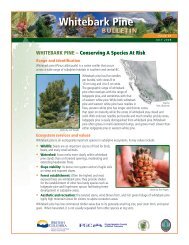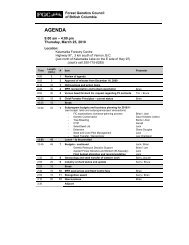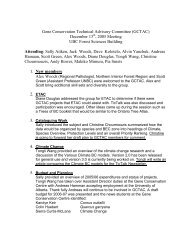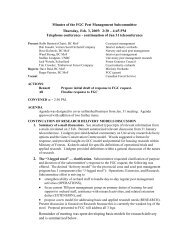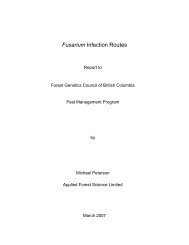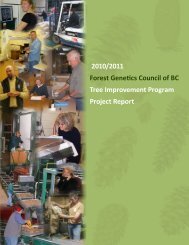Tree Improvement Program Project Report 2006 / 2007
Tree Improvement Program Project Report 2006 / 2007
Tree Improvement Program Project Report 2006 / 2007
You also want an ePaper? Increase the reach of your titles
YUMPU automatically turns print PDFs into web optimized ePapers that Google loves.
Pest management n h gh-elevat on western<br />
hemlock orchard 196 (SPU 2 03)<br />
Orchard 196 consists of 24 clones and 251 ramets. The<br />
mean BV of this orchard is 11.<br />
SPU 2403 covers pest management activities for cone<br />
and foliar insects in Hw orchards to retain the health<br />
and vigour of ramets. Orchard staff conducted weekly<br />
insect surveys and, in consultation with MFR seed pest<br />
management officer, determined that chemical pesticide<br />
applications were unnecessary. Active populations of<br />
Syrphid fly larvae kept hemlock adelgid populations under<br />
control for the <strong>2006</strong> growing season.<br />
.1.13 Sorrento Seed Orchards<br />
H lary Graham<br />
Sorrento Seed Orchard manages two large Lodgepole pine<br />
orchards established in 2003 in partnership with SelectSeed<br />
Company. These orchards will supply seed for the Central<br />
Figureau (CP) low elevation and the Bulkley Valley (BV)<br />
low elevation seed planning units.<br />
To initiate early seed production in these orchards,<br />
pollen management activities were conducted with OTIP<br />
funding in <strong>2006</strong>. Pollen was collected at the Kalamalka<br />
Forestry Centre clone banks and used for supplemental<br />
mass pollination in both orchards in <strong>2006</strong>. All conelets<br />
received up to three applications of pollen during their<br />
receptivity period.<br />
As a result of this work, these orchards will produce seed<br />
in <strong>2007</strong>. We will collect up to 1.26 kg of seed (250,000<br />
plantables) with an expected genetic worth of 15% from<br />
the BV orchard. Approximately 760 grams of seed (150,000<br />
plantables) with an expected genetic worth of 20% will be<br />
collected from the CP orchard.<br />
Early seed production in these young orchards directly<br />
supports the FGC’s goals by making more genetically<br />
improved seed available for use in BC’s forests.<br />
T R E E I M P R O V E M E N T P R O G R A M<br />
P R O J E C T R E P O R T 2 0 0 6 / 2 0 0 7<br />
.2 Techn cal Support <strong>Program</strong>s<br />
.2.1 Cone and Seed Pest<br />
Management – Inter or<br />
Operat ons<br />
Robb Bennett<br />
This project covers operational expenses for the interior<br />
seed pest management biologist’s activities, including<br />
all expenses associated with lab, field, and office work.<br />
Included in this project are wages for one co-op student<br />
(one term) and auxiliary technical support (as needed)<br />
to assist with operational pest management trials, data<br />
analysis, and development of new operational techniques.<br />
The pest management biologist position was vacant from<br />
January until the end of May <strong>2006</strong>, when Jim Corrigan<br />
took over the position.<br />
Between May 23, <strong>2006</strong> and 31 March <strong>2007</strong> the interior<br />
seed pest management biologist provided the following<br />
services.<br />
1. Performed 90 site visits, pest surveys and identifications,<br />
and damage predictions and assessments.<br />
2. Delivered 13 written pest status reports, position papers,<br />
and/or backgrounders for colleagues and superiors inside<br />
the Ministry of Forests and Range and for partners<br />
outside the Ministry of Forests and Range.<br />
3. Prepared ~55 other extension recommendations, pest<br />
identifications, responses to requests for information,<br />
and other transfers of technology.<br />
4. Dealt with ~40 requests for information from members<br />
of the public.<br />
Work continued on in-house and collaborative<br />
development of protocols for seed bugs, seed wasps,<br />
cone worms, mountain pine beetle, and other insects<br />
of importance to interior cone and seed production. In<br />
summary, the interior pest management biologist:<br />
1. Initiated, or collaborated with university, government,<br />
and other research personnel on, nine pest management<br />
projects in the field.<br />
2. Assisted in the preparation of the <strong>2006</strong> mountain pine<br />
beetle risk assessment for PGTIS and Skimikin Seed<br />
Orchards.<br />
3



